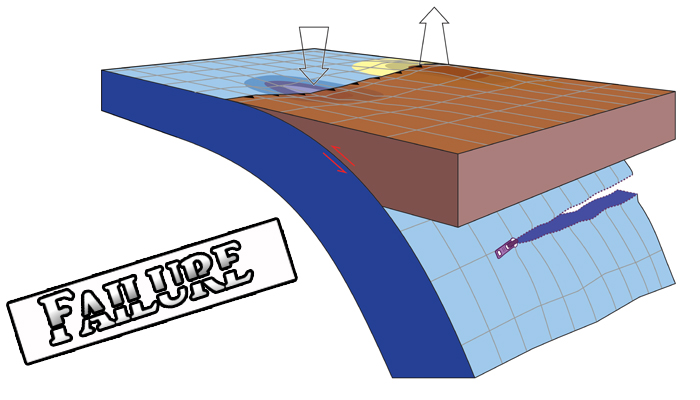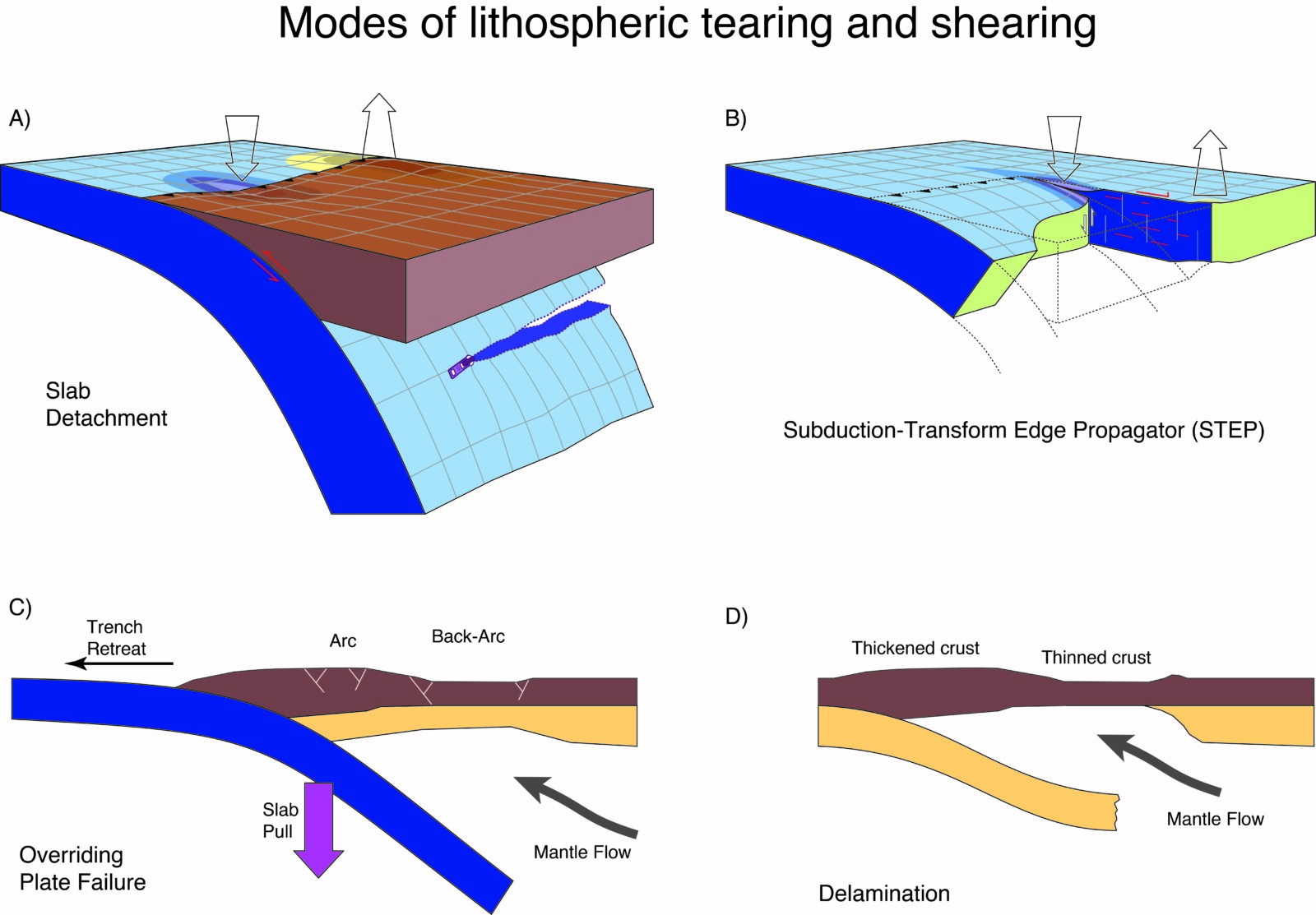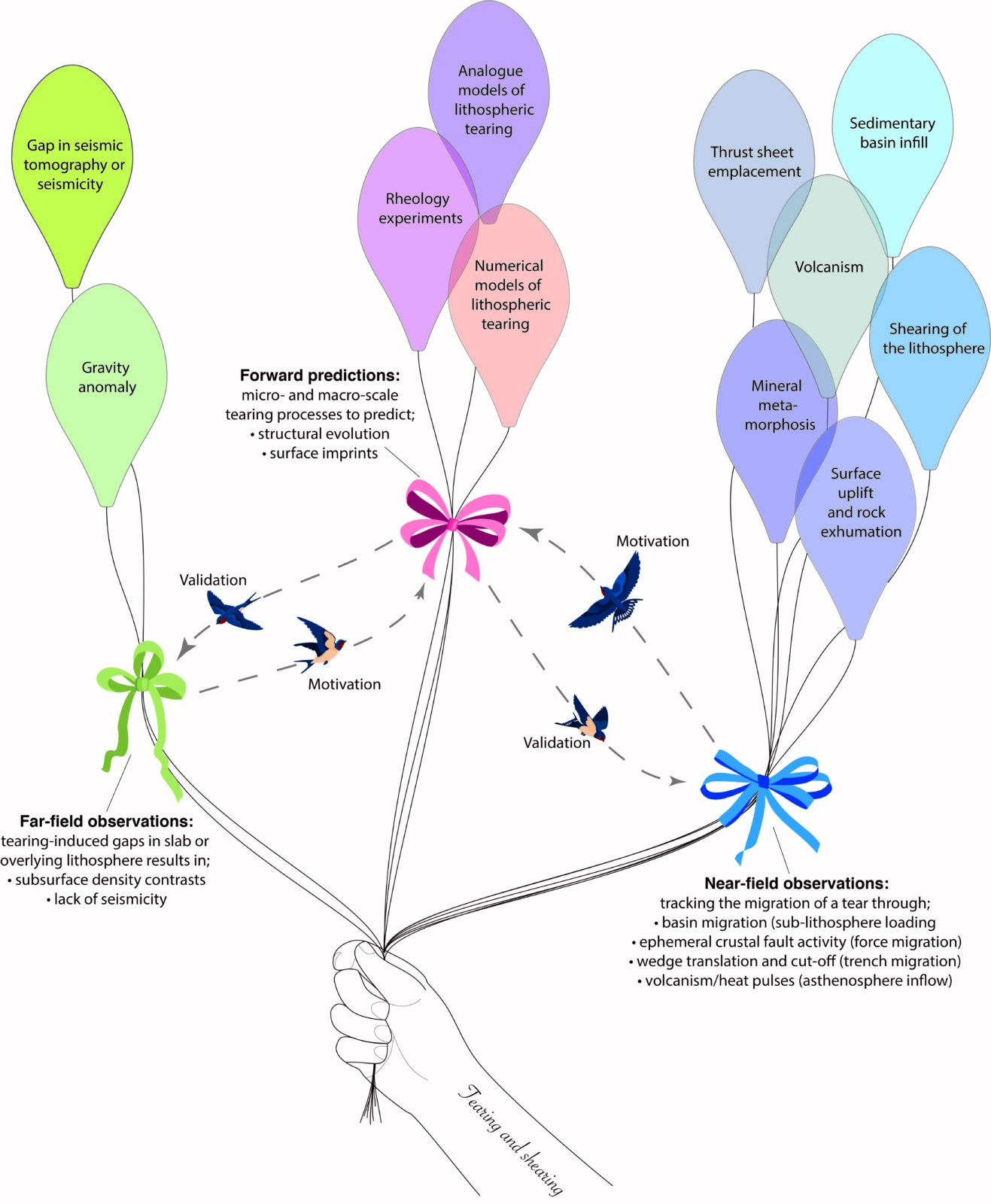
Observing the Earth’s changing surface is the only thing solid Earth scientists can do; we simply cannot drill deep enough into the Earth and look at the processes that occur at very high temperatures and pressures. We must combine surface measurements from various disciplines to infer that specific surface imprints are caused by specific processes at depth. The sinking of oceanic plates into the mantle at subduction zones is a tenet in the plate tectonic evolution of the Earth’s surface. Subduction leads to long incisions or complete break-off of plates that have already sunk, inducing shearing of the surface plates. Slab tearing is a process that we can only observe from the surface as it affects the structure and deformation of the entire lithosphere. Tracking the progression of such tearing at the surface is a realistic possibility. However, distinguishing surface observations are oftentimes not recognized as such. Why is that? In this week’s news and views Nicolai Nijholt, a postdoc at the Aerospace Engineering faculty of TU Delft, Netherlands, puts some light on this complex multidisciplinary topic.
Subduction zones do not run on infinitely in space or time: subduction zones have lateral endings, and at some point in time, buoyant continental material reaches the trench, halting subduction. Tearing and shearing the lithosphere is therefore a common phenomenon in the vicinity of subduction zones, and it requires significant force. The largest force acting on the lithosphere is slab pull transmitted to the surface plates. Deformation induced by the presence of a subducting slab is not limited to that slab itself. More often than not, it includes both nearby lithosphere, such as juxtaposed surface plates and nearby fault systems, as well as the convecting mantle. A broad imprint is thus readily left at the Earth’s (sub)surface for us to measure, recognize, interpret and publish on.

Figure 1 Slab tearing or slab-induced shearing processes. A) Slab detachment, after Wortel and Spakman [2000]. B) STEP faulting [Govers and Wortel 2005]. C) Failure of the overriding plate at the volcanic arc [Boutelier and Cruden 2013] or the back-arc [Karig 1971]. D) Delamination of the lithospheric mantle [Bird 1979].
- Slab detachment (A) occurs when buoyant material is dragged into a subduction zone by a chunk of oceanic lithosphere that has already sunk into the mantle. After the initial localization, the tear propagates laterally (along-strike the trench). At the tip of the tear, the already detached segment is still connected to the undetached segment, resulting in a downward deflection at the surface. Above the already detached part, the surface rebounds. This allows tracking the tear at the surface through basin migration and exhumation of buried materials, and even induced magmatism due to the inflow of hot mantle material in the gap. Some prominent locations are inferred along the entire Alpine-Himalayan orogenic chain [e.g., Garzanti et al. 2017].
- STEP faulting (B) occurs when one part of the lithosphere subducts, whilst the juxtaposed section remains at the surface. The locus of active tearing is dubbed a STEP, and the surface trace left in the wake of a propagating STEP is called the STEP fault. Slab sinking results in downflexing of the surface in the vicinity of the active STEP, which later rebounds when the STEP has migrated onwards. Besides the migration of sedimentary basins and induced volcanism, the presence of an accretionary wedge may also provide a means of tracking a tear; the accretionary wedge displays progressive overthrusting of accretionary wedge sheets whilst the nappes and basins that arise are continually cut-off by a lithospheric-scale transform motion as subduction continues. Some prominent locations are inferred in the Mediterranean [e.g., Govers and Wortel 2005].
- Overriding plate failure (C) accommodates the progressive trench retreat as the overriding plate cannot follow suit. The failure can affect either the volcanic arc or the back-arc, and is associated with lithospheric-scale thinning, basin formation, and an increased heat flow. Some prominent locations are determined in the Western Pacific [e.g., Karig 1971]
- Delamination (D) occurs when a slab of the lithospheric mantle peels off of the crust, similar to sinking slab of oceanic lithosphere. The resulting pattern of crustal deformation is therefore also similar to that in the situation of a retreating trench, yet the amount of mantle lithosphere is severely diminished. Some prominent locations are inferred in the Mediterranean [e.g., Gögus et al. 2017].

Figure 2 Infographic on the relations between the processes of lithospheric tearing and shearing, the observations and models
Observations of lithosphere deforming processes are plentiful; exhumation pathways, basin migration, volcanism localization, kinematic evolution of the accretionary wedge near the edge of subduction zones, pulses of vertical surface motion, et cetera, et cetera. These types of observations can be predicted through forward models of the aforementioned processes. Unfortunately, there is no such thing as a clear-cut interpretation of observations. Take the Mediterranean for example. This natural laboratory constitutes a tectonic setting where the slab tearing mechanisms have been interpreted to have played a major role in shaping the present-day landscape [Spakman and Wortel 2000; Govers and Wortel 2005]. However, rival interpretations of (subsections of) the data forwards different models of crustal deformation [Mantovani et al. 2006] or delamination [Gögus et al. 2017]. So, which interpretation of the data is correct then? Can one unequivocally state that one interpretation is better than the other? The only answer to these questions can and should be that you should pluck as many balloons as you can from the sky (Fig. 2) when in fierce discussion; go for that interpretation which is corroborated by the most diverse set of observations (in both space and time).
The research field of lithospheric tearing and shearing is diverse. And this tearing and shearing occur around the world. Many collaborative opportunities are ahead of us to answer a smattering of questions; Can we determine the sharpness of a lithospheric tear from seismology? Are there different stages in seismic source activity to determine the maturity of a tear (whether it be a STEP or a detachment)? What’s the interplay between a tear and surface fault activity, on any time scale? And this list keeps going on. And on. Maybe your research question is part of the list (especially if it’s just a regional study). Consider submitting an abstract to our session for the upcoming General Assembly of the EGU 2022 (https://meetingorganizer.copernicus.org/EGU22/session/42007). Meet other researchers working on these intricate processes that provide complicated perceptions of the lithosphere-(sub)surface system. Gain insights into the physical/chemical processes whilst noting their potential -yet specific- imprints on the (sub)surface, discover new quantities to compare your models to, and discuss your results with the various experts that constitute this research avenue. Please note that this is a virtual PICO session: when your abstract is accepted, you will be guaranteed a two-minute presentation of your work followed by a chat, even if you do not physically attend the meeting.
References Garzanti et al. (2018), Slab breakoff: A critical appraisal of a geological theory as applied in space and time, Earth-Science Reviews, 177, 303-319, doi:10.1016/j.earscirev.2017.11.012. Govers, R. and Wortel, M.J.R. (2005), Lithosphere tearing at STEP faults: response to edges of subduction zones. Earth and Planetary Science Letters, 236, 505–523. doi:10.1016/j.epsl.2005.03.022. Gögüs, O.H. et al. 2017), Geodynamical Models for Continental Delamination and Ocean Lithosphere Peel Away in an Orogenic Setting. Chapter 5 in Active Global Seismology: Neotectonics and Earthquake Potential of the Eastern Mediterranean Region, Geophysical Monograph 225, First Edition. Karig, D. E. (1971), Origin and development of marginal basins in the western Pacific, Journal of Geophysical Research, 76 (11), 2542-2561. Mantovani, E. et al. (2006), Geodynamic connection between the indentation of Arabia and the Neogene tectonics of the central–eastern Mediterranean region, in Dilek, Y., and Pavlides, S., eds., Postcollisional tectonics and magmatism in the Mediterranean region and Asia: Geological Society of America Special Paper 409, p. 15–41, doi: 10.1130/2006.2409(01). Wortel, M.J.R. and Spakman, W. (2000), Subduction and slab detachment in the Mediterranean– Carpathian region. Science 290, 1910–1917. http://dx.doi.org/10.1126/science.290.5498.1910
